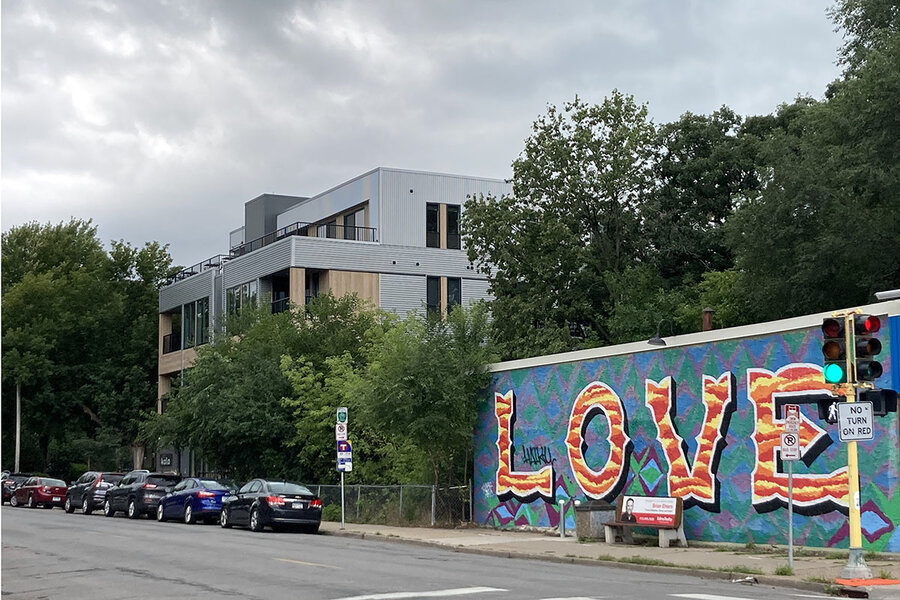Minneapolis seeks housing equality. Is building more homes enough?
Loading...
| Minneapolis
In December 2018, the Minneapolis City Council approved an extensive housing plan that, among other things, put an end to single-family zoning laws.
The since-dubbed Minneapolis 2040 plan has allowed for multifamily development projects in neighborhoods with single-family homes. The goal is to create denser housing near transit, fight climate change, and eliminate racial and economic inequalities.
Why We Wrote This
A story focused onDoes building more multifamily homes make housing more affordable? Not so far in Minneapolis, where residents are finding that factors like NIMBY and racism are keeping housing equality elusive.
But while Minneapolis 2040 was heralded as revolutionary when it was introduced, many question its efficacy at truly addressing the housing shortage and reducing disparities. Three years after the plan was implemented, Minneapolis and its neighbor St. Paul were found to have the worst housing shortage in the nation.
There has been a disconnect between residents who say they’re in favor of creating more affordable housing and what that reality looks like in their own neighborhoods. Many locals are wondering, can Minneapolis 2040 bring housing equality?
“The ‘not in my backyard’ concept is an age-old issue, particularly in wealthy, whiter neighborhoods,” says Anthony Damiano, a researcher in housing policy.
“That’s something that the 2040 plan really does try to address, by increasing the amount of allowable density. ... But we need to monitor other changes in the housing market. You can’t just do the 2040 plan and call it a day.”
Sarah Hopkins has lived in her two-story gray house on this relatively quiet block in northeast Minneapolis for six years, in harmony with her fellow renters, homeowners, and multifamily dwellers.
But she has mixed feelings about the changes her block is about to see. The city recently approved a local development project to build a four-story, 23-unit apartment building on a single lot across the street.
“It’s a weird place for an apartment,” says Ms. Hopkins, whose street is one block from a busy thoroughfare. “The aesthetic does concern me, and it will be a lot of extra action on the block. Where will they all park? What type of people will be living there?”
Why We Wrote This
A story focused onDoes building more multifamily homes make housing more affordable? Not so far in Minneapolis, where residents are finding that factors like NIMBY and racism are keeping housing equality elusive.
“If the housing is affordable, I’ll be fine with it,” says Seth Wester, a renter on the same block, out on a morning walk. “But as a millennial, 100% affordable housing? I haven’t seen it.”
The ambivalence of residents here is common across Minneapolis when it comes to housing development. In December 2018, the Minneapolis City Council approved an extensive housing plan that, among other things, put an end to single-family zoning laws.
The since-dubbed Minneapolis 2040 plan has allowed for multifamily development projects – mostly duplexes and triplexes – in neighborhoods with single-family homes, and removed certain restrictions on multistory apartment complexes on commercial streets. The goal is to create denser housing near transit, fight climate change, and eliminate racial and economic inequalities.
But while the Minneapolis 2040 plan was heralded as revolutionary when it was introduced, many question its efficacy at truly addressing the housing shortage and reducing disparities. Three years after the plan was implemented, the Twin Cities – Minneapolis and its neighbor St. Paul – were deemed by the United States Census Bureau as having the worst housing shortage in the nation.
And despite Minneapolis’ liberal majority, there has been a disconnect between residents who say they’re in favor, in theory, of creating more affordable housing and what that reality looks like in their own neighborhoods. Many locals are wondering, can the Minneapolis 2040 plan bring housing equality?
“The ‘not in my backyard’ concept is an age-old issue, particularly in wealthy, whiter neighborhoods, of people using their political and economic power to keep affordable, subsidized housing out,” says Anthony Damiano, a postdoctoral fellow and researcher in housing policy and structural inequality at the University of Minnesota.
“That’s something that the 2040 plan really does try to address, by increasing the amount of allowable density. It’s a conscious effort to make up for generations of past discriminatory practices ... but we need to monitor other changes in the housing market. You can’t just do the 2040 plan and call it a day.”
“I don’t know how I feel about it”
When Minneapolis introduced its 2040 plan in 2018, it was already deep into a housing crisis. Since 2000, the city has lost around 15,000 affordable housing units, and in 2017, the Minnesota governor’s task force found that the city was short of around 50,000 homes.
The success of the 2040 plan hinges on the changes to single-family zoning, which put Minneapolis ahead of major cities like New York and Seattle, which still only allow single-family homes in certain areas.
But the city is at a building pace similar to that before the 2040 plan went into effect, and the removal of single-family zoning restrictions has only accounted for the construction of about 1% of new units. Officials say only around one-third of the 150,000 units authorized for construction will actually be completed by 2040.
The vast majority of new development projects here consist not of duplexes and triplexes, but of apartment complexes of five or more units. The 2040 plan’s inclusionary zoning requirements mandate that larger buildings must provide a percentage of affordable options for low-income renters. But critics say the costs of building affordable units could discourage investors, ultimately reducing supply and raising housing prices overall.
“I looked into living in that apartment but it was ridiculously expensive,” says Zach Cozine, pointing to the 41-unit apartment across the street that opened in September 2020. The building – built in a boxy style with flat wood-panel siding that is typical of new complexes around the city – offers rentals from $995 to $2,495 per month.
“I like to see new buildings going up, but it drives up the rent for everyone else,” says Mr. Cozine, who works at a coffee shop on Bryant Avenue in southwest Minneapolis. “It’s not all bad or good. I don’t know how I feel about it.”
The continued housing crunch is partly due to the lag time between housing construction and housing sales – residents here haven’t necessarily felt the long-term effects of the Minneapolis 2040 plan yet.
Still, a Federal Reserve Bank of Minneapolis tracker showed that permits for multifamily buildings had underperformed in the last year. Dr. Damiano from the University of Minnesota says that the inclusionary zoning ordinance is good, but a drop in the bucket. And when it comes to truly low-income housing, “there is absolutely not enough,” he says.
There are hopes that Minneapolis Mayor Jacob Frey’s proposal to put up to $18 million toward affordable housing will make a difference.
“This neighborhood has been such a huge part of my sense of community, but the prices are higher than further outside the city. Things have gotten crazy,” says Whitney Anne, who works at the coffee shop with Mr. Cozine and rents an apartment down the block.
She sees developers here trying to pack in more people, get rid of cars, and price out her neighbors. The median home value in Minneapolis is over $335,000, and the average rent for a one-bedroom is more than $1,550 per month.
“I don’t see a solution for myself,” she says. “I’ve been casually shopping for other places to live. For my survival, it might be time to move.”
“You can’t have it both ways”
In addition to creating affordable housing, the 2040 plan has tried to reduce the racial disparities that have affected the city’s housing market for decades. As early as 1910, homes in certain neighborhoods of Minneapolis included racial covenants: documents that banned owners from selling or renting to people of certain races, primarily Black residents.
Though the covenants have been banned since 1968, they contributed to pushing racial minorities into the outskirts of the city, creating segregated pockets and disparities in homeownership that still exist today. In 2019, Black homeownership in Minneapolis was the lowest rate of any metro area in the U.S. at 25%, compared with a white homeownership rate of 77%.
Since George Floyd was murdered by a Minneapolis police officer in May 2020, residents have become even more attuned to the city’s problems with racial inequality. Yet the changes to single-family zoning requirements have continued to create controversy among some residents. Nextdoor, an online neighborhood community platform, is filled with complaints about what multifamily units or low-income residents would bring to wealthier areas.
“Minneapolis is highly Democrat in politics but very racist when it comes to dealing with our problems,” says Mike Wedl, who was part of a working group at the Humphrey School of Public Affairs in Minneapolis that helped write the 2040 plan. “We want to make sure poor people have access to jobs, etc., but we don’t want them to live in our neighborhood. Let’s quit pretending – you can’t have it both ways.”
The Family Housing Fund is one organization working to help people, especially households of minority racial and ethnic backgrounds, become more informed and proactive about homeownership. It helps to ensure that homes are affordable, to replace exclusionary screening processes, and to enable those with low and moderate incomes to increase homeownership opportunities. Since last year, it’s helped 30 people buy homes in the region.
“We’re trying to remind people that everyone deserves a place to live, and our neighbors are the same folks as where our children go to school together, where we work together. Housing is so foundational to someone accessing health care, maintaining their employment, and accessing higher education,” says Kirstin Burch, program director at the Family Housing Fund.
“We want to show that there’s a whole ecosystem that housing contributes to so that people feel more compelled to support more affordable and more accessible housing in their communities.”
The Minneapolis 2040 plan is still a work in progress, as residents remain wary of how new housing will directly impact their neighborhoods as well as whether true systemic change will come with it.
“People need to live. The city is building things, but they’re not affordable,” says Mackenzie Owens, a homeowner in south Minneapolis, taking a break at the coffee shop. “I support density. I’m not against building more apartments, but I’m trying to think of if it was in my neighborhood how I’d feel about it. ... I guess if it’s affordable, I’m for it.”









